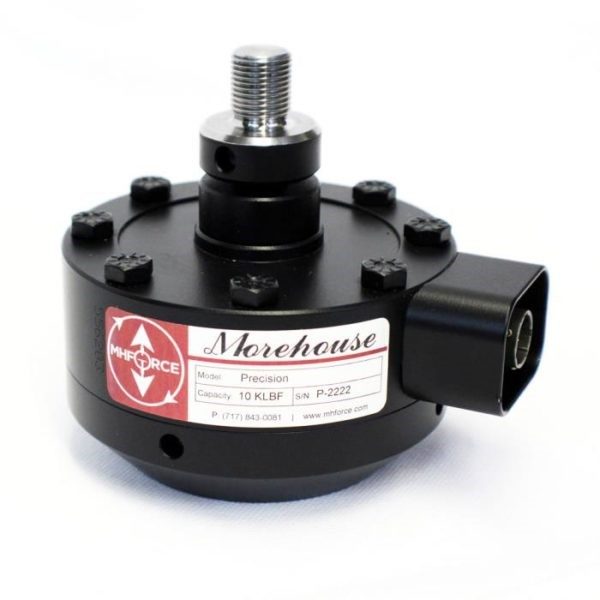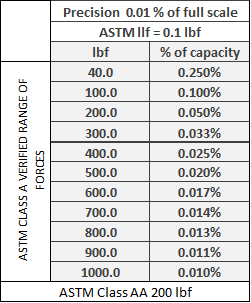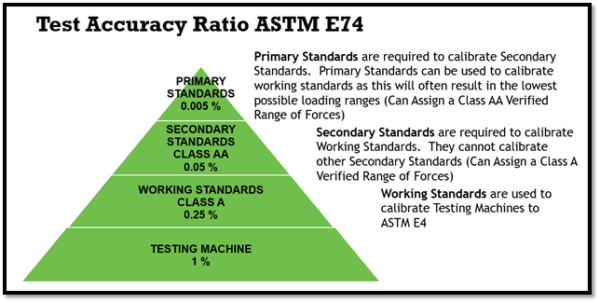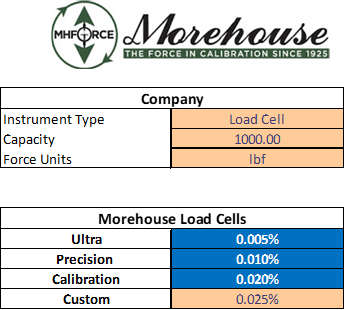ASTM E74 Load Cell Selection Guide
Download the spreadsheet for ASTM E74 load cell selection spreadsheet here.

Many people get confused with load cell specifications and what they mean. When a company says the load cell is accurate to 0.01 % of full scale, what does that mean? If calibrated using the ASTM E74 standard, the meaning differs from a pure accuracy specification. The ASTM E74 calibration is much more robust than a simple single-run commercial calibration or a calibration in which acceptance limits are reduced by measurement uncertainty and a pass/fail conformity assessment is made.
This article will discuss the simple-to-use ASTM E74 Load Cell Selection Guide. For example, when we specify a load cell is good to better than 0.01 % of full scale, we are saying the load cell will have an ASTM Class A verified range of forces (usable range per ASTM E74) of better than 4 % through 100 %.

The above table breaks the ASTM E74 criteria down. On a 1,000 lbf load cell, the ASTM E74 llf (how well the load cell performs when conditions are varied or reproducible) will be better than 0.1 lbf. The Class A loading range will be 400 x 0.1 (ASTM E74 llf) or 40 lbf. If calibrating a testing machine that is accurate to 1 %, the first force point is exactly 4:1, or 4 times better than what is being verified to ASTM E4. The 40 lbf point is known to be within 0.25 % of the applied Force.

This correlates well with the above picture showing the different accuracy ratios. Working standards need to be better than 4:1 when compared to the accuracy of the testing machine. Secondary standards, those calibrated by primary standards, need to be better than 0.05 % of applied Force. These standards are assigned a Class AA verified range of forces. In our example above, if deadweight primary standards calibrated the load cell, a class AA verified range of Force would be calculated by multiplying 0.1 lbf by 2000. The result would be an ASTM Class AA verified range of Force of 200 through 1,000 lbf. At the 200 lbf test point, the device is known to be within 0.05 % of the applied Force.

Our easy-to-use ASTM E74 Load Cell Selection spreadsheet calculates everything for you based on entering the capacity of the load cell and units. Anything in Orange would be filled in. The table includes a Custom field where someone can make assumptions on the specification to see what the useable range would be.

Once everything is entered, the table will calculate everything. If someone wanted a Class AA verified range of forces better than 10 % of the load cells capacity (0.05 %), a Morehouse Ultra-Precision Load Cell would need to be purchased. These load cells can be used as low as 2 % and sometimes 1 % of capacity to verify testing machines to ASTM E4. Everything is shown in the table for the end-user to make the most informed decision about which load cells meet the appropriate specification.
In most cases, Morehouse Precision Load Cells will yield the best performance-to-price ratio as they are often usable below 4 % for ASTM E74 calibrations. Thus, the end-user can calibrate a broader range and carry much less equipment than if they purchased a load cell that was only accurate to 0.025 % of full scale.
The other point to make here is that the calibration supplier must have the capability to calibrate the equipment to ensure accuracy. If the requirement is 0.01 % of full scale, can a supplier with a Measurement Uncertainty of 0.025 % calibrate a load cell to 0.01 % of full scale? Simple math, right, yet many load cell manufacturers do not have equipment with measurement uncertainties better than their specifications. Thus, there is no way you can purchase a load cell from them and expect to maintain 0.01 % of full scale when their scope of accreditation says their measurement uncertainty is higher than that.
Part of any risk mitigation strategy should consider the following:
- Selecting a calibration supplier that offers the smallest measurement uncertainty (Look at the scope of accreditation for your supplier and verify their measurement uncertainty is lower than your requirements)
- Utilizing the appropriate reference standards (ASTM E74 selection guide should help)
- Improving reliability by managing calibration intervals (follow ASTM guidelines of a 1-year initial calibration interval on new equipment and then increase if specifications are met)
- Monitoring of standards using control charts (Morehouse has a 5-in-1 force verification system to help. Info can be found here)
- Continual improvement of the calibration processes (We all want to continually be better. Investing in employee education, equipment, and learning as much as possible. Morehouse has an eBook that can help, download is available here)
ASTM E74 Load Cell Selection Guide - Conclusion
Morehouse wants to help educate our customer base on what we do and how we do it. We are always looking to improve our capabilities and yours. Knowledge is power. We hope this article has helped you understand the importance of selecting the right load cell when following the ASTM E74 standard. We hope our ASTM E74 Load Cell Selection spreadsheet will further simplify your selection process. Please continue to check out our blogs and the documents and tools section of our website for information guaranteed to help you start making better measurements.
Download the spreadsheet for ASTM E74 load cell selection here.
If you enjoyed this article, check out our LinkedIn and YouTube channel for more helpful posts and videos.
I take great pride in our knowledgeable team at Morehouse, who will work with you to find the right solution. We have been in business for over a century and focus on being the most recognized name in the force business. That vision comes from educating our customers on what matters most and having the proper discussions relating to force calibration basics so that everyone speaks the same language.
Everything we do, we believe in changing how people think about Force and torque calibration. We challenge the "just calibrate it" mentality by educating our customers on what matters, and what causes significant errors and focusing on reducing them.
In addition, Morehouse makes simple-to-use calibration products. We build fantastic force equipment that is plumb, level, square, rigid and provide unparalleled calibration service with less than two-week lead times.
Contact us at 717-843-0081 to speak to a live person or email mailto:info@mhforce.com.


